Why is the usually dependable Johnny Cueto struggling so badly?
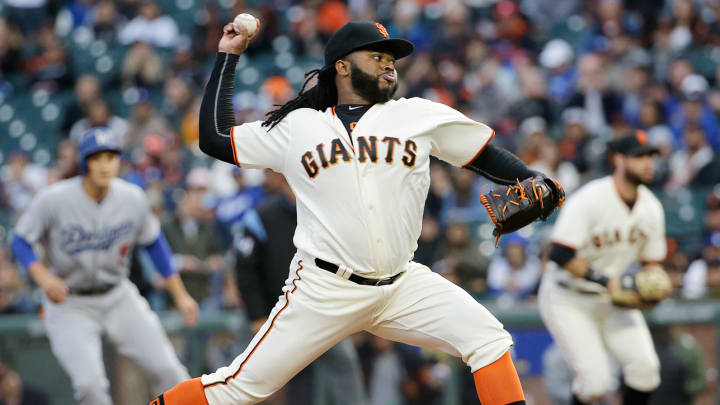
There’s no shortage of candidates for worst April in the MLB. The Mets went 10–14, their offense is as bad as expected, and Noah Syndergaard and Yoenis Cespedes are both on the disabled list. The Blue Jays are 8-17, the second-worst record in baseball, and their once mighty offense is now among the game’s weakest. The Royals, which won the World Series just two years ago, have seemingly had their window slammed shut; they have the worst record in the league at 7-16 and have scored a shockingly anemic 63 runs in their 23 games. The Pirates and Mariners, both considered playoff contenders at the start of the season, are in last place in their respective divisions, and the Pirates lost their best player, Starling Marte, to an 80-game PED suspension. Any of these team’s would be an appropriate choice as April’s greatest trainwreck.
For my money, though, no team had a worse April than the Giants. At 9–17, they’re in last place in the NL West, seven games behind the Rockies after entering the season with World Series aspirations. One month into the season, they’re mired in mediocrity, their offense looks listless, and their best, most indispensable player—Madison Bumgarner—is on the DL with a shoulder injury suffered because of a dirt biking accident. Sorry, Mets, Blue Jays, Royals, Pirates and Mariners, the Giants are April’s biggest losers.
Syndergaard injury just the latest example of one of baseball’s biggest problems
A major part of the Giants terrible April was Johnny Cueto. The typically steady ace compiled one of the worst calendar months of his career. Cueto made five starts in April, pitching to a 5.10 ERA, 5.08 FIP and 1.40 WHIP in 30 innings. He struck out 24 batters, walked 10 and surrendered six homers. A famously durable pitcher who’s one of the few remaining starters reliable for going deep into games, Cueto pitched into the seventh inning in just two of his starts. Compared with his career numbers, his strikeout, walk and HR/FB rates all trended in the wrong direction. Cueto, one of the most bankable pitchers of the decade, has been anything but this season.
First and foremost, Cueto’s velocity is down this season. That probably shouldn’t be a surprise for a pitcher in his age-31 season who came into the year with nearly 1,700 innings under his belt, but it must be noted. Cueto’s velocity has been trending down for the last two seasons, but it has reached a new low this year. The chart is courtesy of Statcast, with Cueto’s four-seam fastball velocity of 90.55 mph purposely highlighted.

That’s a disconcerting trend for any pitcher, and it really stands out this season. Remember, MLB is now using Statcast data to track velocities after years of using Pitch F/X, and those two systems measure velocity differently. Pitch F/X measured the pitch in flight, typically about five feet from home plate. Statcast, meanwhile, takes the fastest measurement it can find, which is always going to be right when the ball leaves the pitcher’s hand. That has resulted in velocity readings generally being up about one mph across the board this season. That means that a dip of two mph, like Cueto has experienced year over year with his four-seamer, is, in reality, a three-mph decline. His two-seamer, meanwhile, has lost about 1.5 mph this season compared with last year.
This velocity has killed Cueto’s bottom line. He’s allowing more hard contact than ever before, with Fangraphs tracking his hard-hit rate at 39.2%. His career number is 27.2%, and his previous career high is 31%, which came with the Reds back in 2009. His HR/FB ratio is 18.8%, nearly twice his career rate. Cueto’s fly-ball rate is in line with career norms, but his line-drive rate is up about four percentage points, the exact number by which his ground-ball rate has declined. In other words, hitters are squaring up Cueto’s offerings more than they ever have, and that’s further reinforcement that his velocity is down.
Thanks to Statcast, we can further isolate velocity as the main issue. Last week, we broke down Kenta Maeda and found location and command, rather than velocity, at the root of his struggles. Such is not the case for Cueto. The following zone profiles from Statcast show Cueto’s location percentage by zone. The first is from last year, and the second is from this year. All graphs presented in tandem will follow the same pattern.
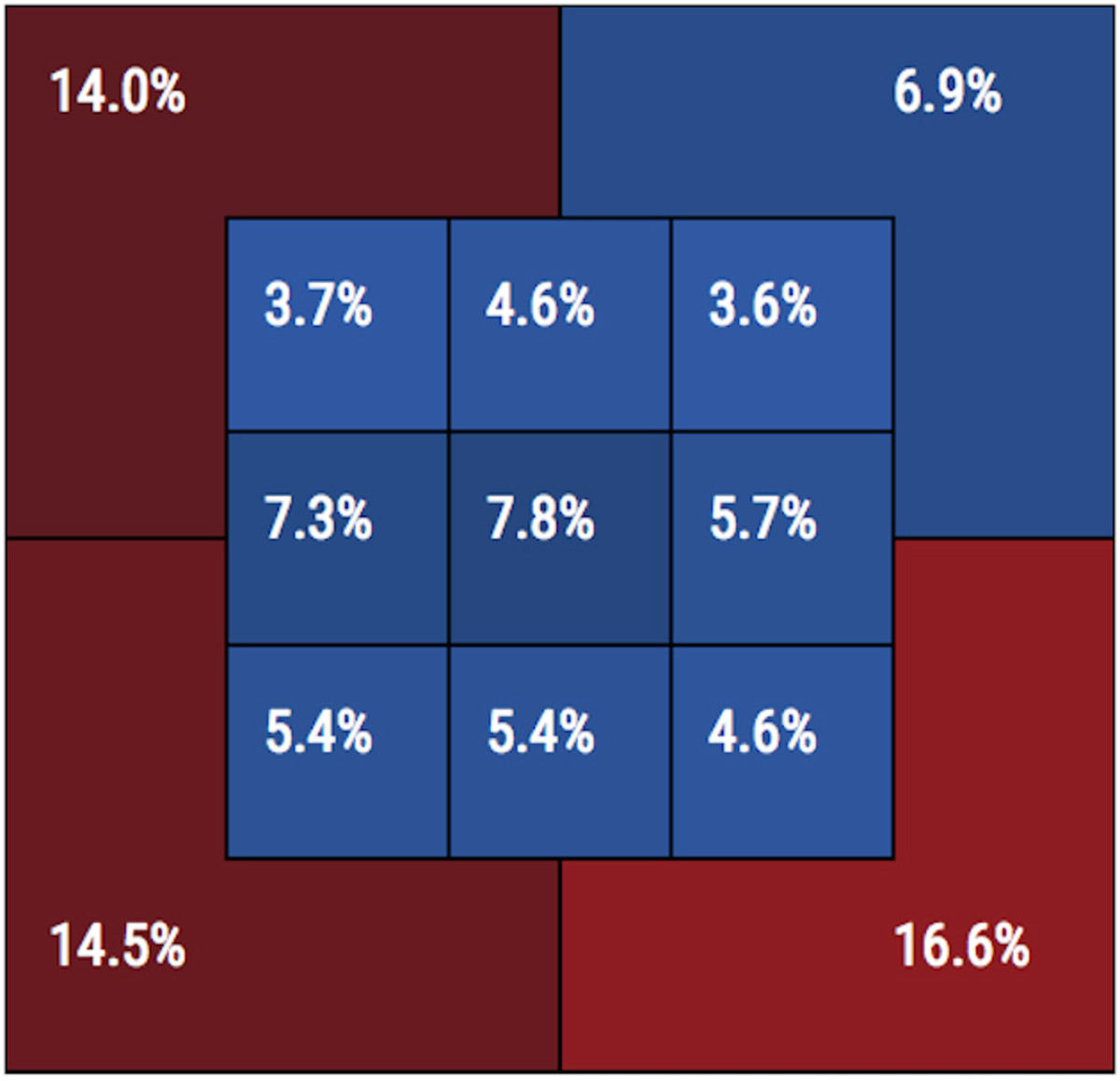
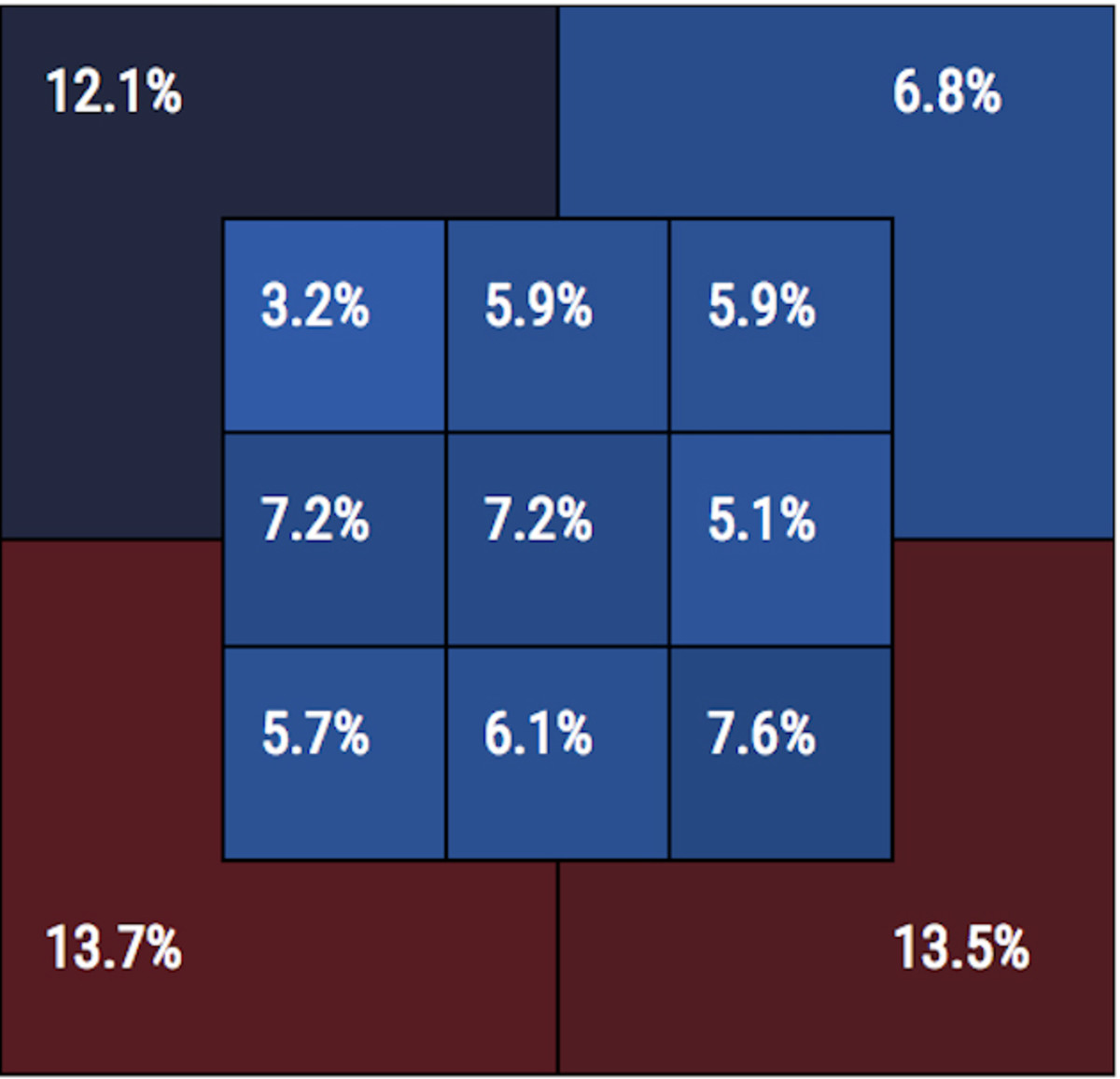
There are some differences, of course, but they’re negligible. Cueto has been in the zone at the belt or above slightly more often this year than he was last year, but not to the point that it explains his troubles. The difference lies in how much more successful hitters have been on pitches in the zone. We’ll start with batting average against. Now, of course, there is some noise in batting average statistics, but the gulf from this year to last year is so wide that it is instructive.
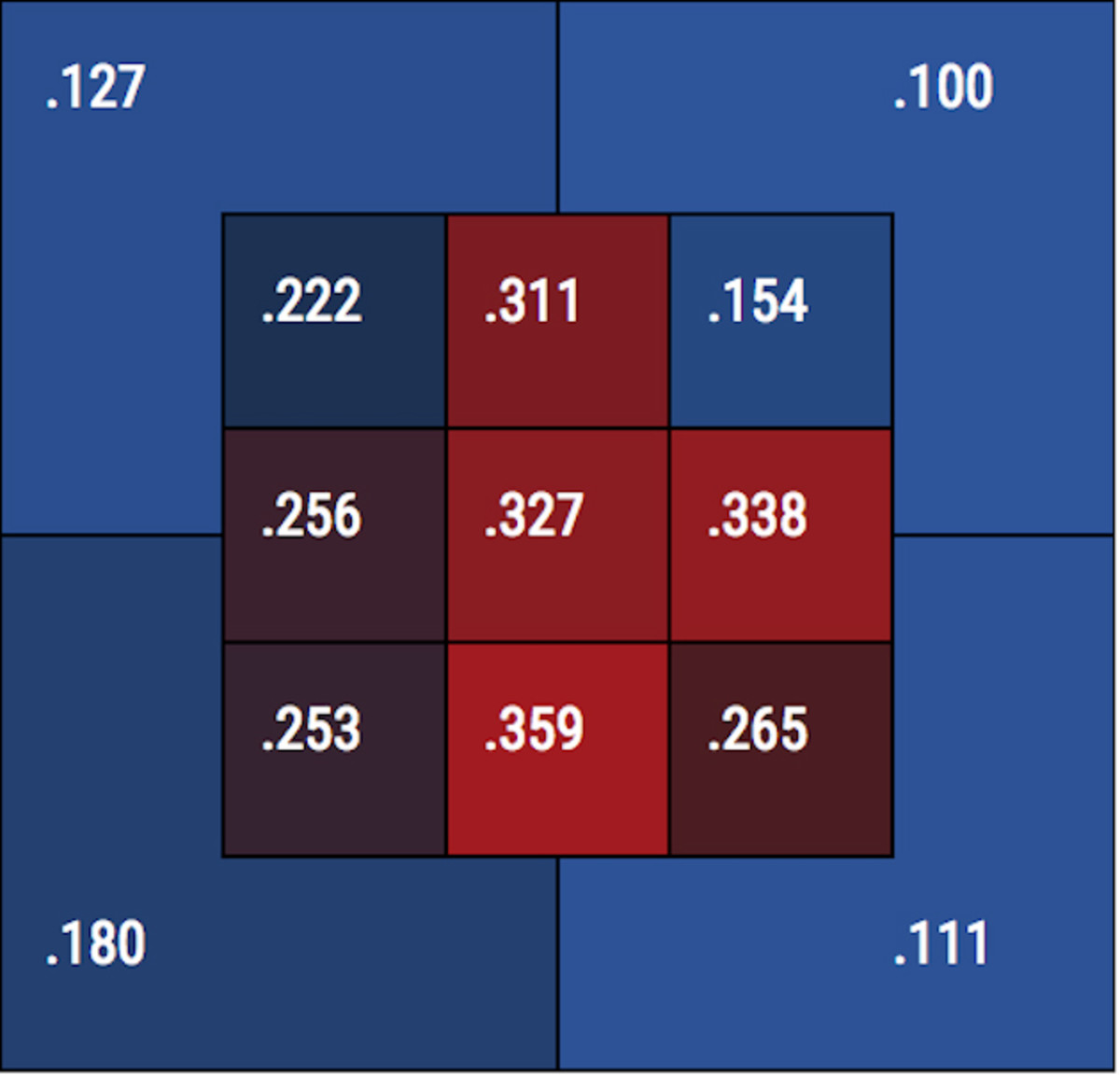
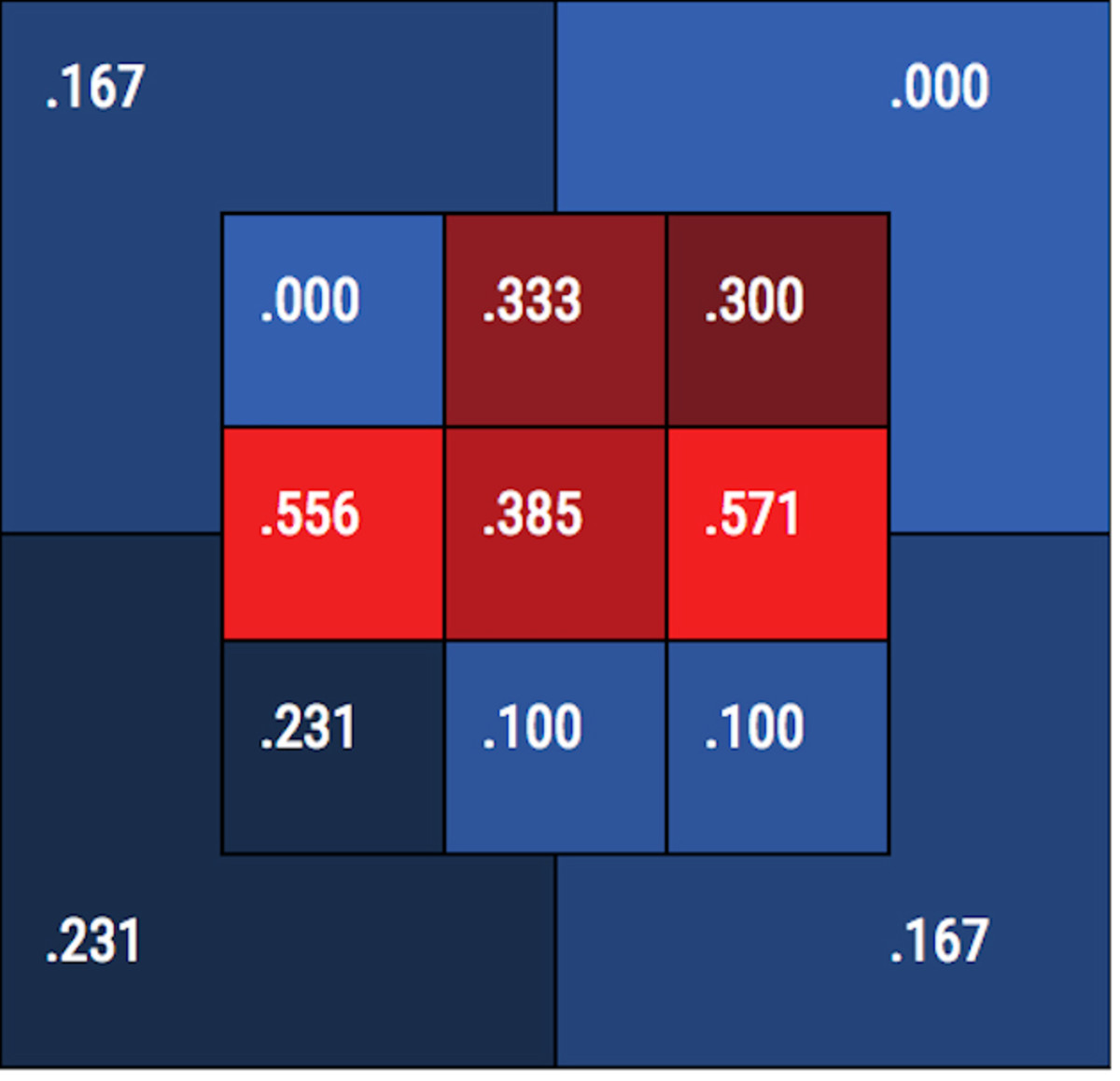
Every pitcher is going to have ugly numbers on pitches put in play in the middle of the strike zone, but Cueto’s this year are off-the-charts bad. This, too, comes back to more hard contact, as we can see from Cueto’s exit velocity against by zone.
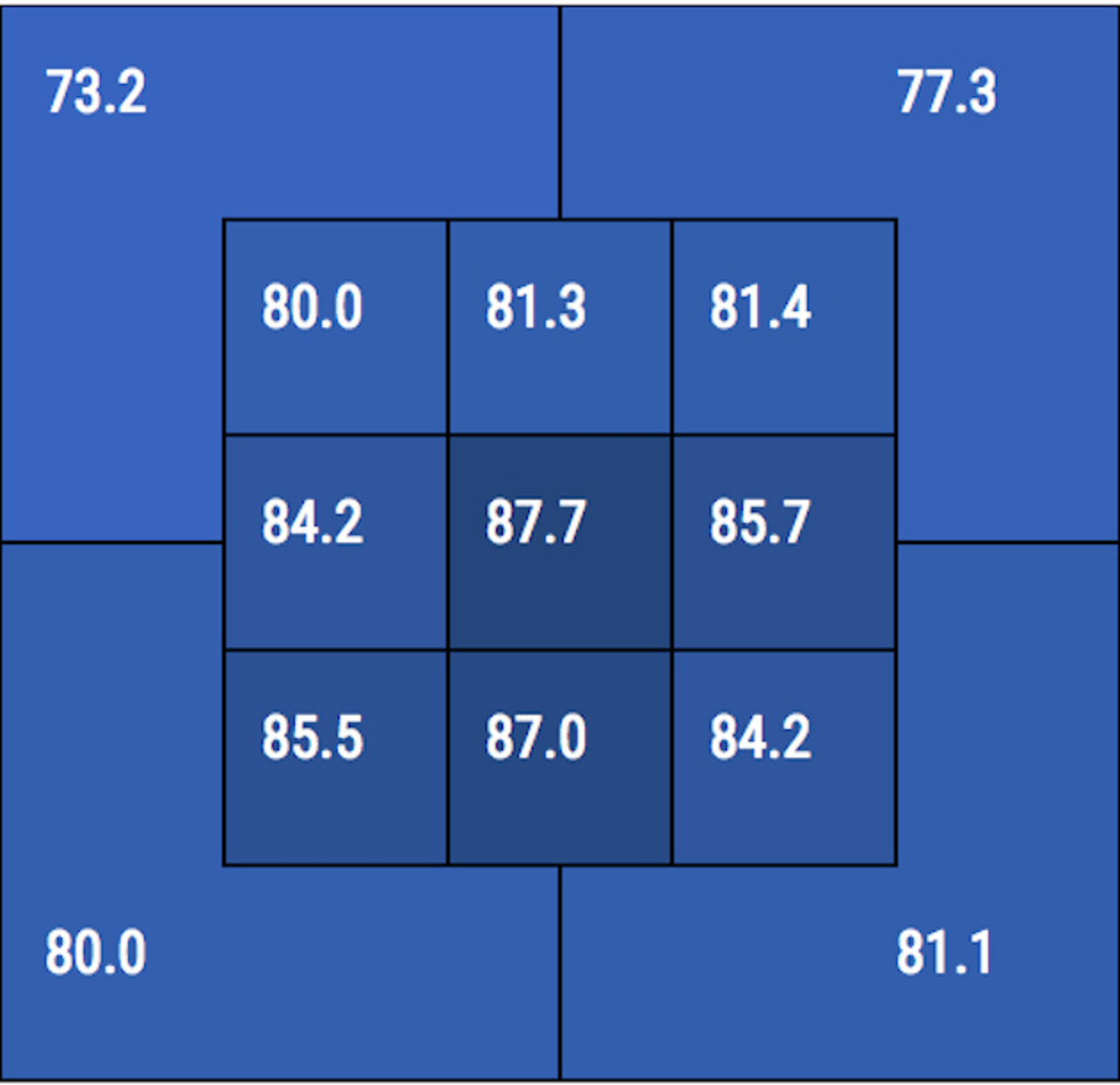
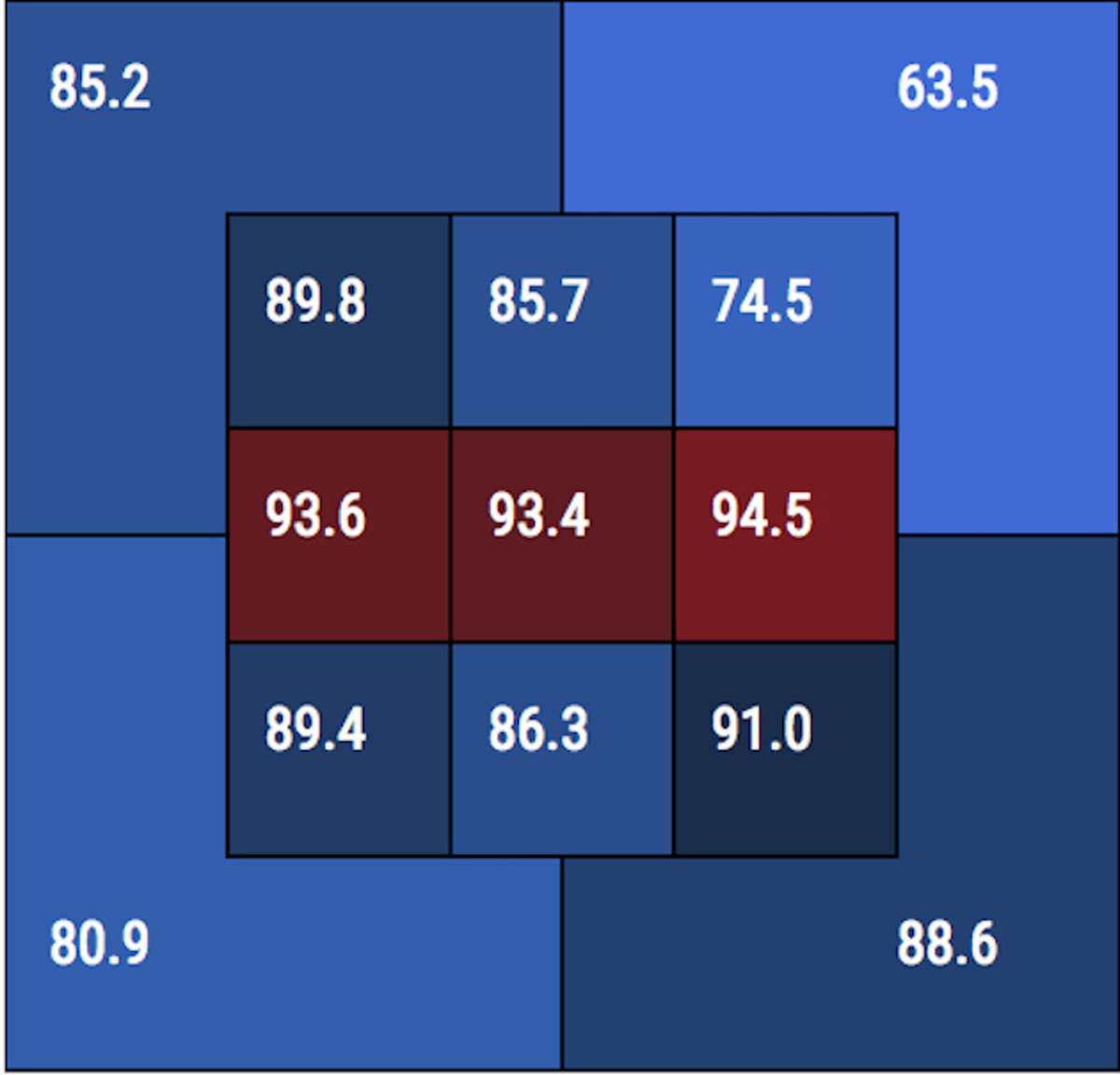
The hard-hit issue is even worse when you isolate for right-handed hitters.
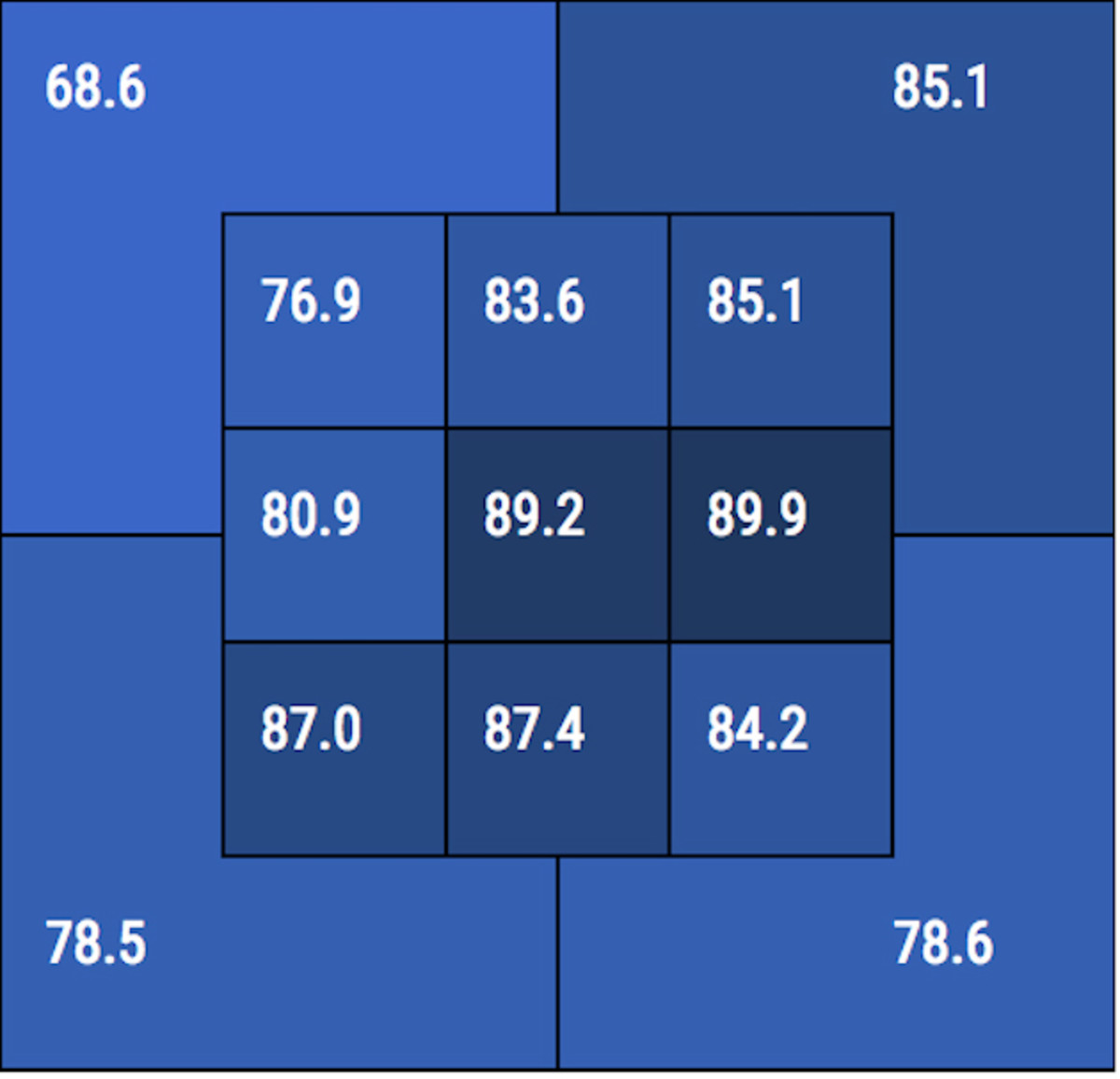
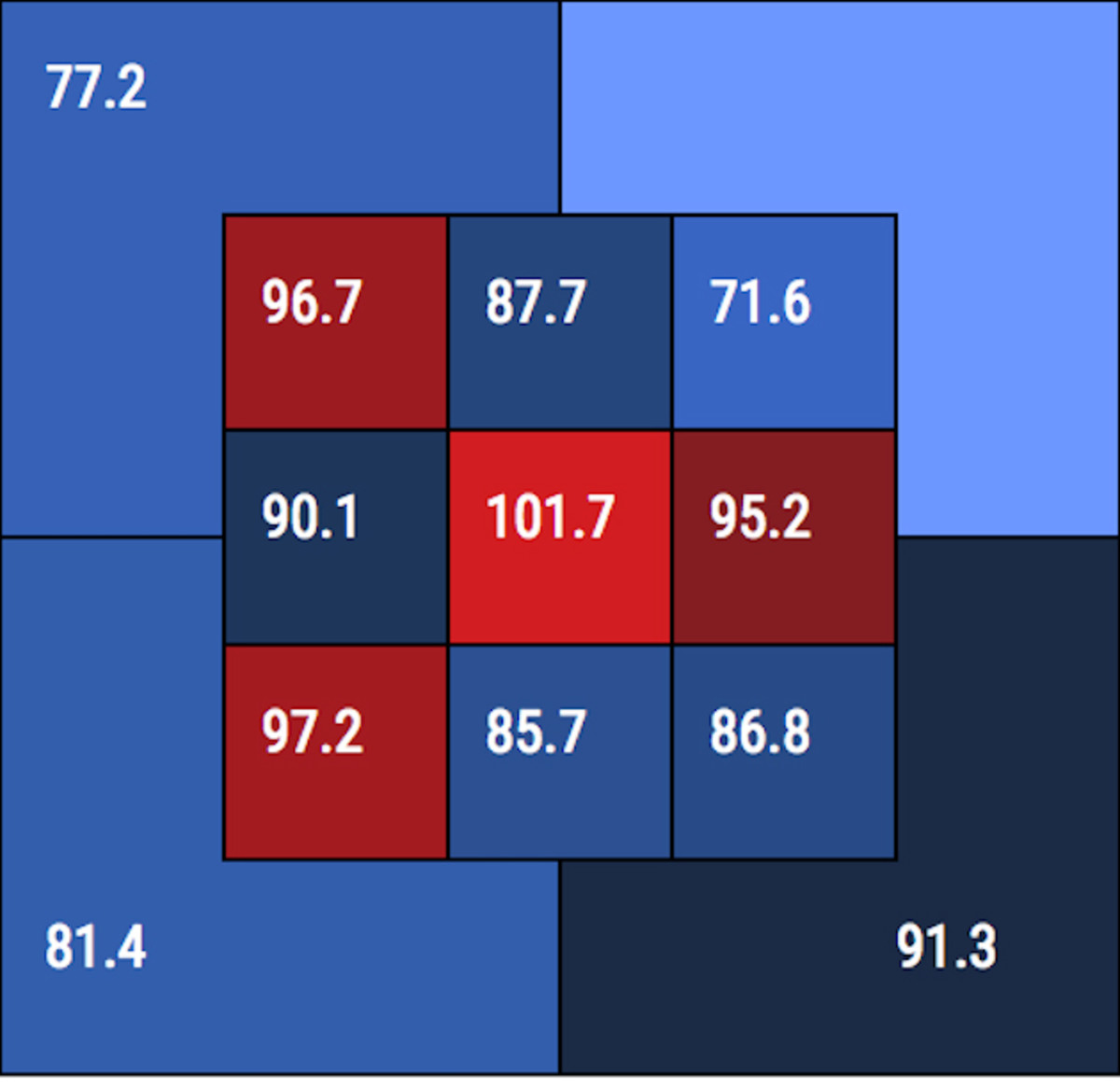
Cueto has always had some mild reverse splits, but those have picked up this season. Righties are hitting .281/.349/.456 with three homers in 65 plate appearances against Cueto. Those exit velocity numbers prove that the slash line is not a fluke.
To recap, Cueto is 31 years old. He’s now north of 1,700 innings for his career, including the postseason. His velocity has been trending down for years, and has reached its lowest point this season. Finally, he’s getting hit harder than ever before in his excellent career. All of those factors hint at, but don’t necessarily confirm, an injury. There could be even tougher days ahead for the Giants and Cueto’s fantasy owners.
Pitchers to watch this week
Danny Duffy, Royals
The White Sox lit up Duffy in his last trip to the mound tagging him for six runs on nine hits and two walks in 4 2/3 innings. The lefty will take on the White Sox in his next start, as well, this time at home on Tuesday. Duffy had been great before getting shelled by the White Sox, allowing four runs and striking out 22 batters in his first 27 1/3 innings, a stretch covering four starts. Last week’s rough outing against the White Sox looks like nothing but a blip on the radar. He’ll make a second start this week, taking the ball against the Indians on Sunday.
Gerrit Cole, Pirates
Cole was electric in his last start, limiting the Cubs to one unearned run on two hits in seven innings, striking out eight and walking none. Unfortunately, his offense couldn’t get anything going against Kyle Hendricks, and he took a very tough-luck loss. Anyway, it was Cole’s second straight start with eight strikeouts, and that’s a key number to watch. Despite a fastball that has always sat around 96–97 mph, Cole has never put up gaudy strikeout totals, fanning a batter per inning just once in his first four seasons. That has prevented him from being a true fantasy ace, but if he’s turning a corner in the strikeout department, he could be in for the best season of his career. Cole has two scheduled starts this week, with the Reds on tap Monday and the Brewers on Saturday.
After refusing an MRI, Syndergaard's latest injury clouds Mets with more questions, doubts
Jose Quintana, White Sox
Quintana scuffled to start the season, barely clearing the low bar for a quality start two times in his first four outings. He turned in a gem in his last start, though, striking out 10 Royals while allowing one earned run on five hits in six innings. He’ll see those same Royals on Tuesday, before a weekend turn against the Orioles. Quintana is likely to pitch his way out of Chicago at some point this season, and is the odds-on-favorite to be the best pitcher dealt in advance of July’s trade deadline. We still haven’t seen him go exceptionally deep in a game this season, though all those strikeouts were largely responsible for holding him to six innings in his last start. The Royals have been especially punchless this season, so Quintana owners should be excited for his week ahead.
Jerad Eickhoff, Phillies
Eickhoff struggled in his last start, allowing five runs on nine hits and three walks in 5 2/3 innings in a loss to the Dodgers. It was his first bad turn through the rotation after four strong outings to begin the year, though he does not yet have a win to show for it. Still, he owns a 3.56 ERA, 3.52 FIP, 1.25 WHIP and 28 strikeouts in 30 1/3 innings this year. If he can maintain that pace over the same 197 1/3 innings he threw last year, he’ll easily turn a profit for his fantasy owners in all formats. He’s scheduled for one start this week, taking on the Cubs at Wrigley Field on Wednesday.
Prospect Watch
Brent Honeywell, Rays
Over the last decade or so, the Rays have proved their organization-wide ability to nurture pitching talent in the minors, producing no shortage of MLB starters. Honeywell could be the next pitcher in that line as soon as this season.
Honeywell, who’s in his age-22 season, is at Triple-A Durham for the first time in his career after starting the season in Double-A Birmingham. He has thrown 11 2/3 innings in his two outings with Durham, allowing five earned runs on 11 hits, including three homers, striking out 10 and walking two. Never mind the exact results for a second. Honeywell’s stuff should play well in the top level of the minors, evidenced by the 10 whiffs in his first 11 2/3 frames. He struck out 53 batters in 59 1/3 innings with Montgomery last year, and 20 more in 13 innings before getting promoted to Durham. There’s no doubt that the righty can miss bats.
Should Honeywell make the majors this year, he’d instantly have one of the most interesting repertoires in the game. Honeywell throws a legitimate screwball, which moves like a curveball but breaks in the opposite direction. Hector Santiago is the only recent pitcher in the majors to recently use the pitch, but even he goes to it sparingly. The pitch is a true weapon for Honeywell, as we can see here.
If and when he brings his act to the majors, Honeywell be immediately relevant in all fantasy formats.
Two-start Pitchers
Clayton Kershaw
Chris Sale
Jon Lester
Lance McCullers
Corey Kluber
Danny Duffy
Jose Quintana
Justin Verlander
Gerrit Cole
Johnny Cueto
Carlos Martinez
James Paxton
Julio Teheran
Cole Hamels
Rick Porcello
Jake Odorizzi
Marco Estrada
Luis Severino
Ervin Santana
Matt Shoemaker
Tanner Roark
Jason Vargas
Wei-yin Chen
Robert Gsellman
Amir Garrett
Dylan Bundy
Taijuan Walker
Michael Wacha
Trevor Bauer
Daniel Norris
Edinson Volquez
Andrew Cashner
Tyler Chatwood
Brett Anderson
R.A. Dickey
Wily Peralta
Tyler Glasnow
Mike Fiers
Zach Davies
Scott Feldman
Trevor Cahill
Dylan Covey
GIF of the Week
Zack Greinke struck out 20 batters in 12 innings across two starts last week. Eleven of those came in a win over the Padres. Let’s take a look at all of them, shall we?
